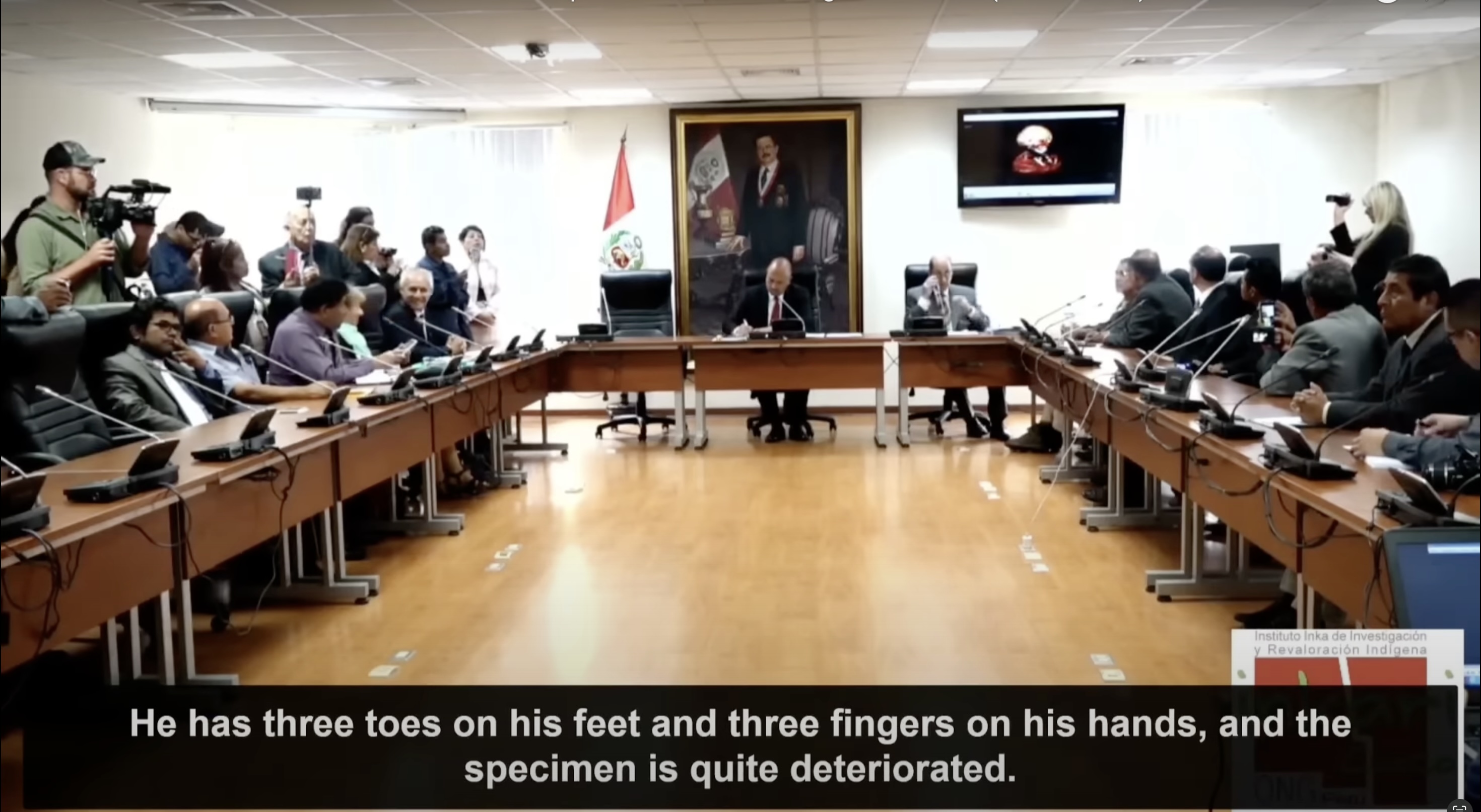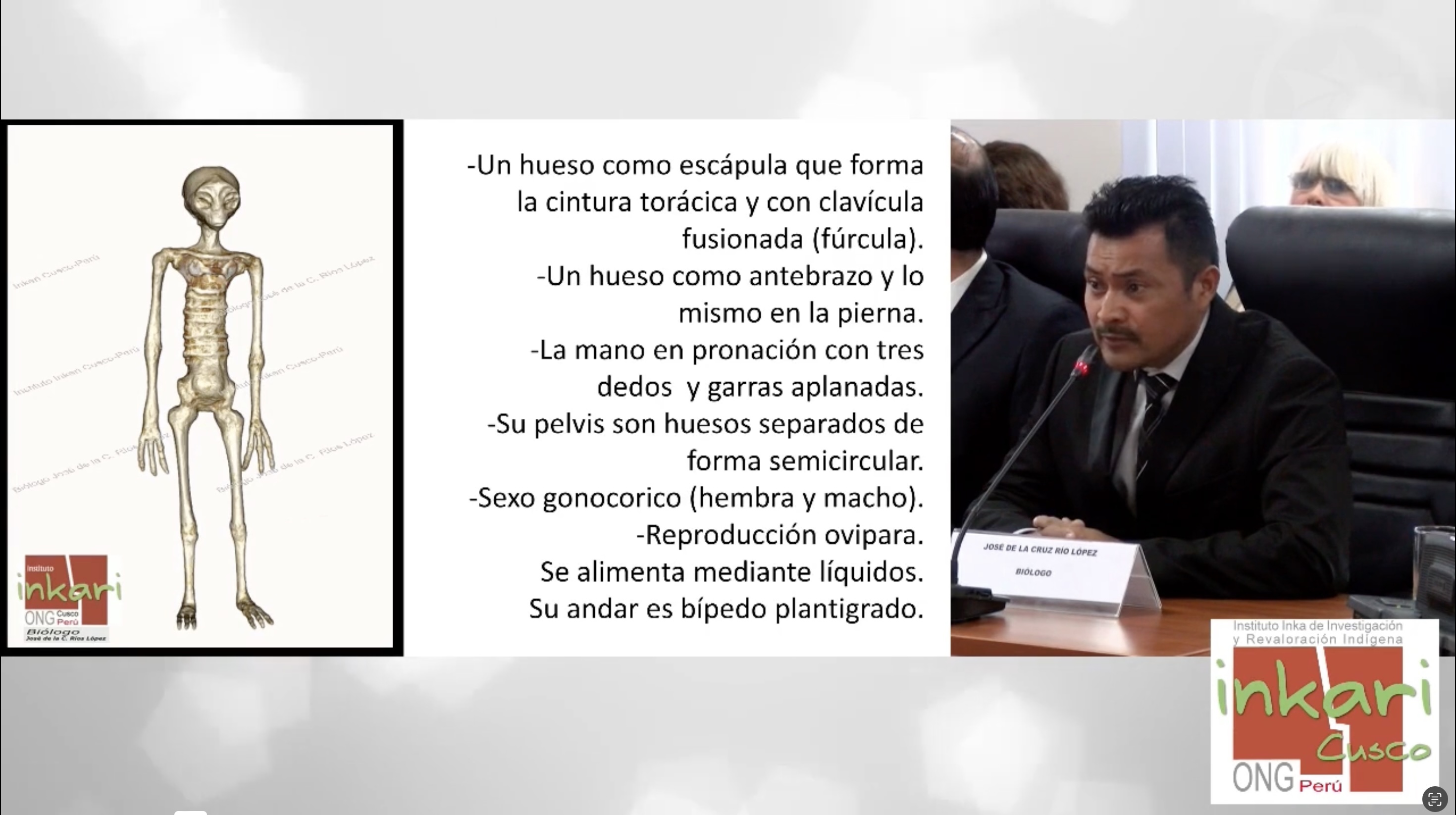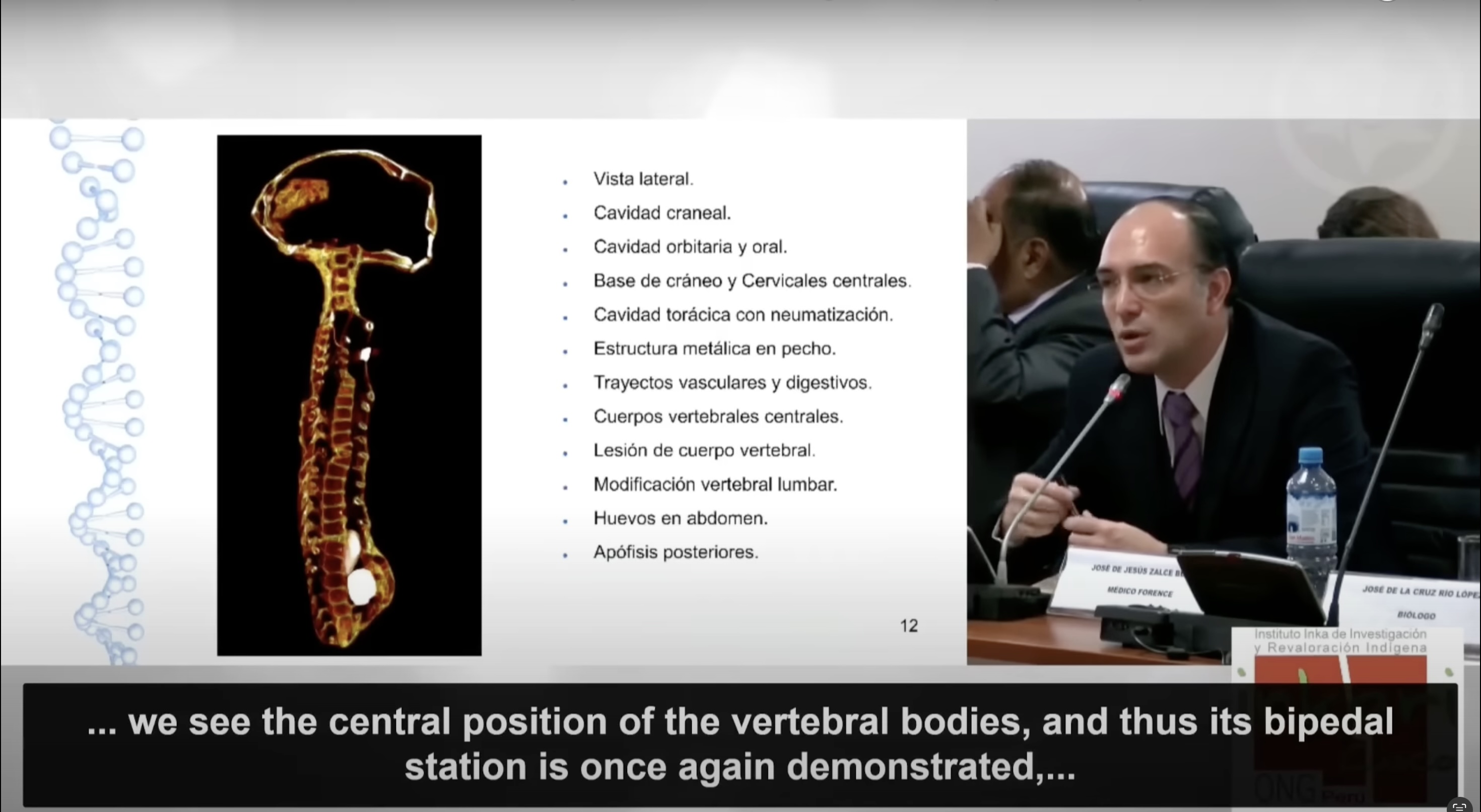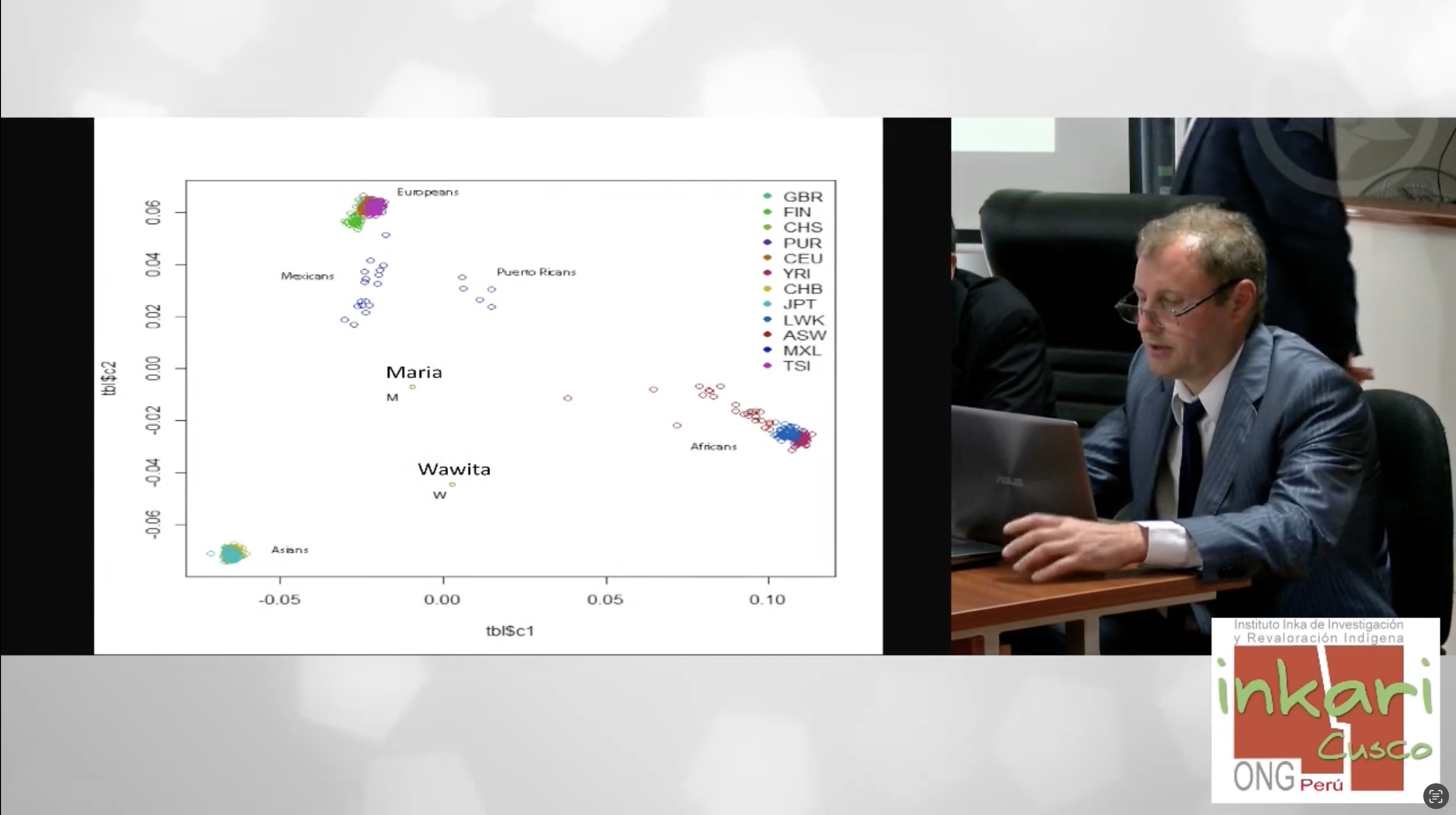Nazca Mummies:
Highlights From the Peru Hearing (November, 2018)
January 4, 2024

Below is a list of highlights from the 2018 Peruvian hearing on the Nazca mummies. This event was held to present the findings of the first official investigation of the mummies, before the bodies were given to the University of Ica investigators for further study (whose results were presented at the 2023 Mexican hearing, you can read my highlights for that here).
Like the University of Ica team, this first group of investigators also reaches the unanimous conclusion that the mummies are authentic and represent a new, unknown species.
Sidenote: You can watch the full hearing on YouTube or here's my edited English transcript.
Sections
Dr. Raymundo Salas Alfaro - Radiologist
Regarding Maria:
Well, this is the most famous mummy after Tutankhamen. It is going to be the most famous.
another important characteristic in the feet is that it has linear horizontal fingerprints; they are not arched as we know normally
Well, according to the objectives we have set for ourselves, we can say that Maria is apparently female due to the nipples and gynecoid pelvis, indicative of an estimated age between 40 and 45 years old
The cranial capacity is 19 percent more
José de la Cruz Ríos López - Biologist

The purpose of the analysis was precisely to identify two possible species, which would be in the case of the little ones of 60 centimeters, the object of analysis was Josefina, who would be this properly one type that has been analyzed and subsequently María, who we have designated with names such as "Humanoid Reptilian" in Josefina's case and “Jamin Palpanensis” in María's case.
regarding the place of origin, it is unknown where it was found. However, it is known that it would be between the localities of Palpa and near Nazca, which has also been mentioned that it could correspond to a cave or a diatomaceous earth deposit, and that it would be found at the top of a hill
They contain organs, are humanoid in shape, with characteristics similar to those of reptiles. That is, they do not have hair, they do not have an auricle, they do not have a nasal septum, there are no nipples, and the skin is of the type that uses scales, among other characteristics.
Regarding gender, we could say that they are gonochoric; that is, there are females and males in their reproduction. It would be oviparous, and their nourishment would be through liquid, and their gait would be bipedal plantigrade.
this specimen has a square foramen magnum and totally different from any known species on Earth.
we find two holes behind the orbital cavity here, the interesting and essential thing in these specimens is that we see the presence of three windows or three orifices, which scientifically does not correspond to an identification that has been provided by science.
We did a comparative study between the cranial perimeters of different terrestrial species, in this case, quadruped mammals, and what we find is that the cranial perimeter is too large in this 60-centimeter specimen. The common denominator among each of these species is that between each one of them, we found a reduction of that cranial perimeter in such a way. There is no possibility that this skull could belong to any quadrupedal mammal animal, as has been mentioned or attempted to discredit the case
We have identified little holes that would be the optic nerve holes, and also on the upper part of the viscerocranium skull we have determined the presence of these holes that would have allowed the brain connection to parts of the skin,
These specimens do not have teeth, but we see two structures or two hinge plates there. Here we see the oral opening part. We see a type of alimentary opening at the back of the oral opening. There is a small hole, and previously, Dr Jesus Zalce pointed out in his observations that this being could have been nourished with liquid. The tomography exams demonstrate that indeed, it could have been the case since it does not have a mastication system. What could have served as food could have been acquired through a process of liquid destruction. So, that liquid swallowed goes to the lower part. That would correspond to what we call jowls; in this case, in them, it would be a kind of bag, a sort of container where that consumed liquid would go and that possibly would have had an absorption process that we do not know for now.
An important feature of these specimens is the presence of what is known as the furcula. The furcula itself is the union of the clavicles, and we can only find this same characteristic in extinct dinosaurss, the so-called theropods, from which we know that the current birds, which have that same characteristic, are derived. Only those two known groups, one extinct and one currently the birds, correspond with the anatomy of the clavicles of this being. And comparing it with that of the birds, its morphology is totally different.
Here is a very important aspect with respect to this specimen, we have identified this type of vascular nerve tracks that come precisely from the skull, from the brain, toward the body parts, and here we can see in the tomographies, the ducts that come out through the first vertebrae and these ducts come out on the periphery of those vertebrae. It does not have a proper orifice in each cervical vertebra, but these bundles come out around them
Clearly, we have a biological reproductive system already characterized. We have been able to say that there is a reproductive apparatus in this specimen and it consists of, and we see here an elongation of what could be an oviduct, similar also to reptiles, but with a difference with its shape to release the eggs. And here we clearly see that the content in different points of the tomography shows, the presence of an egg in a stage of development.
Here is a very important fact with respect to the tridactyl hands: we can identify that the hand is made up of a single carpal bone with three fingers, and each finger is made up of three phalanges, and it is very likely that this finger ends in a flattened claw. This characteristic of the three fingers and the hand in pronation is characteristic of theropods or extinct dinosaurs.
And we see areas of cavities that form the bone structure. Well, going back again to the issues of bone cavities, we find that these beings have hollow bones. It has been talked about and it has been argued falsely that they would correspond to bones of assembled animals. Clearly, this type of characteristics in these bones is impossible to find in any mammal. This argument can be completely dismissed, we can only refer to bones of extinct dinosaurs, and if we want something more recent, the birds also have that characteristic.
Another important detail is that the vertebrae are also found to be hollow. It also does not correspond to a characteristic of any terrestrial mammal animal, but we can refer to an extinct specimen, in this case exemplified, to have an idea of it, it is a dinosaur that is called Mamenquisaurus, which is a dinosaur that possessed hollow vertebrae in the neck. So these similarities do not seem strange to us and are known by science.
Here we have identified everything that is the vertebral column, we have already properly characterized it, in which we can verify that there are 31 vertebrae and distributed as follows: 1 atlas, 4 cervical vertebrae, 7 scapular vertebrae, 14 dorsal vertebrae, and 3 pelvic vertebrae, and the last 2 would be sacral vertebrae. It has 11 ribs, 9 ringed, and two floating. It has at least 5 different types of vertebrae throughout the vertebral column.
Here again we see the sacral structure that consists of two vertebrae in the terminal part of the column of this specimen. Yes, this is important to note that like other groups of extinct dinosaurs, in the case of the Herrerasaudidae, of the saurischian dinosaurs, also presented two vertebrae that functioned as sacra.
It has a broad bone as scapulae joined to the 7th vertebrae that would form the rib cage, which is characteristic never recorded in any known animal group.
A very important aspect is to be able to determine the common ancestor of this being. Well due to the fact that there is no differentiation of bones such as radius and ulna in the forearm, tibia and fibula in the case of the leg, by evolutionary homology, this would not correspond to a biological origin or a common ancestor with any species we know today. Although, it has a certain anatomical or analogous relationship with the hands of extinct theropod species, in this case that could be the Velociraptor. It seems that within its evolutionary line there was the Archaeopteryx, since they present this characteristic of the tridactyly of 3 phalanges in the hand and the single bone that would form the carpals.
In conclusion, the specimens analyzed present characteristics that collectively we would expect from a specimen corresponding to a species either reptilian or humanoid and already feel in their phenotypic characteristics they are found to be more related to the group known as reptilian, without an auricular flag, absence of nipples or mammary glands, absence of hair, absence of five fingers, etcetera.
The eggs of the reptile or hand in their morphology are simple, symmetrical similar to that of reptiles. A variety of phenotypic characteristics of the Humanoid Reptile are observed, such as: furcula, hollow bones, pronation of the hand, tridactyl hands and feet. These are found in the theropod group, extinct dinosaurs from approximately 65 million years ago. The presence of a bone for the forearm and leg corresponds to this humanoid specimen, the Humanoid Reptilian, making it distinct in its evolution from a common ancestor known on earth. Its evolution is therefore different from any species known on earth.
Dr. José de Jesús Zalce Benitez - Forensic Specialist - Mexican Navy

we find a body specifically of 60 centimeters of type harmonic between their parts, structures with fine physiognomy and compatibility between all of them, anatomical integration of anthropomorphic form. This means that it has a head, it has a trunk, it has limbs, it has hands, it has feet, it has a structural integrity that is compatible and continuous. With this I mean that there is no indication that they have been assembled or constructed artificially, it expresses a development in a natural way as a single individual. It is a biological specimen with functional anatomy natural form features.
I'll start with the head. The skull is of a single piece, although it has its sutures as already pointed out. Sutures are the unions of the various bones that integrate the skull, but it is a single piece, that is, it was not carved, it was not fabricated nor was it made from another previous piece but it has a unique origin.
It has an anthropomorphic physiognomy, that is: two eyes, a nose, a mouth. It resembles, but it is not, human. The nasal fossa and the oral cavity are functional, derived from an analysis made of the images to which we had access. By functional I mean the nasal fossa received air to breathe, the orbital cavities had eyes to see, and the oral cavity had the function of feeding.
What can be very well seen is the digestive tract that goes over the part of the lower bone, where there is the neck, and goes towards a posterior region, and here comes the interesting part, posterior to the vertebrae. The known species have the digestive, or swallowing apparatus, or the esophagus in front of the vertebral body, and here it is seen that it has a path posterior or after the vertebral body.
The base of the skull is different with a central support. This central support coincides fully with the location of the foramen magnum, and the foramen magnum has specific rectangular characteristics with clear edges and not of circular or ovoid type as in other species. It is found located in the middle third of the skull when in most species it is located in the posterior third.
It has vascular packages that can be observed and probably nerve packages visible with different paths. On the back part of the vertebral bodies. we can find there a descending path, that could be what we were talking about, the digestive tract or it could even be accompanied by a nerve tract package. On the part in front of the vertebral bodies, starting its entry into the thorax in a diagonal in a red line, that would be the vascular path. This is very striking, since the vertebral bodies, instead of being located in the posterior part, are located in a medial part of the organism. There is a direct correlation between the orifices of the skull with entry or exit grooves of neurovascular packages. That is, the skull presents holes that allow the entry and exit of a vascular packages, and the nerve packages, making a functional anatomy, are very difficult to replicate or reproduce artificially.
One, the thoracic cavity in a lateral view, the three vascular and digestive pathways already described, which here can be specified how they come out from the back of the vertebral bodies and reach towards the median structure. It can be observed that the column, and the vertebral bodies, are in a medial position at the center of the specimen, having a posterior apophysis or above average. This results in the spinal column occupying almost completely the entire thoracic structure. The images seen in black at the center of the slide confirm the existence of pneumatization, which most likely used to be the respiratory system.
Here we have the location of the metallic pectoral plate embedded, and it is striking that this metal plate, which is embedded in the front part of the thorax, precisely instructs the anatomical structure, but it is neither sewn nor attached artificially. Instead, it adheres harmoniously to the surface, forming a continuity with the skin surface.
The absence of a pelvis as such is striking - this means that the lower limbs could not have a circular amplitude of the limb but could only have anterior and posterior movement, that is, linearly, and not be able to have the amplitude that we know.
There, in the vertebral bodies, there is a separation or angulation. That is a physiological response, normal in the gestation process. This would be very difficult for someone to have been able to replicate so harmoniously something that happens naturally in a gestation process. The body adapts and changes its structure to be able to receive this gestation process, and there it is clearly seen how the vertebral bodies change their position, widen the intervertebral space, and have a functional harmonic relationship with that gestation process, corroborating the originality and natural biology of this specimen.
The union of the lower pelvic limb makes a wedge on the surface of what would be the femur, and that wedge that is seen there is precisely the wear of the upper bone, equivalent to the iliac, with the femur bone in its displacement. That natural wear from the biomechanical movement of bipedal standing could not be subject to an artificial replication by an artist. It is a natural wear of the specimen because of its existence, that is one way to corroborate it among many others.
We move on to the hands, and in the hands, as already described, we see that there are only three fingers, each finger with five phalanges, and between each phalanx, the articular capsule is clearly seen. This means that it has an articular capsule, muscle, tendon, and ligaments. Here they are observed clearly, and this is difficult to replicate, practically impossible. In a lateral view, we can see the articular capsule perfectly, and this articular capsule has a direct correlation between one phalanx and the other, giving a natural specificity without the option of doubt that it was assembled or put together. On the contrary, it tells us perfectly about the functional anatomy of the hand, with a type of winding. That is, there is no way to grip with an opposable finger, but the length of the phalanges allows us to make a type of winding for holding things.
By studying these images, and their three-dimensional reconstruction, it is possible to identify that the bony anatomy, as well as the ovoid structures—the four eggs—the soft anatomy such as skin, fat, muscles, organs, blood vessels, oral cavity, digestive tract, reproductive system, and oviduct, and other joint structures like muscles, tendons, ligaments, and cartilage, do maintain a direct relationship between their position and trajectories, which manifests their authenticity and organic functionality, which is unique and unrepeatable among individuals. This determines the viability and feasibility that it is an entity of a new or unknown species in its biological evolutionary origin, unique and different from what has been described or known in the human species or any other.
Prof. Galetskiy Dmitriy Vladislavovich - First University of Medicine of St. Petersburg, Russia

This simple fact gives us the guarantee that no alterations have been made to the phalanges of this specimen's fingers. We have analyzed the DNA of these two samples. We have already seen these reports from our previous colleagues, and we have also come to the same conclusion. According to the DNA analysis that has been carried out, we can conclude that this specimen does not belong to any identified race that inhabits the planet Earth.
We can hold the theory that this specimen is a representative of a race still unknown to science.
It is almost certain that the wounds this person has were made by animals with very long claws.
You can see the cavities clearly—cavities corresponding to the location of the heart and lungs. Likewise, we see the presence of fecal residue, intestines, liver, in the abdominal cavity. But we have not found kidneys, genital organs. What we see here is that Maria also has only three fingers. What we do not find in Maria's hands are the muscles that connect the phalanges. This means that this person has not been able to close—has not been able to make the movement of closing her fist, for example—due to the absence of the muscles between the phalanges.
And as for the heel, we see that it has a different shape. It shifts slightly downwards; this indicates that the person was unable to put all the sole of her foot, to make contact with the terrestrial surface. This indicates that this person, when walking, was supported only by her toes and heel.
The part where the skull and the spine meet, which we suppose is the atlas, has a different shape from that of human beings. The most interesting thing is that it has a squared shape, unlike that of human beings. Not only human beings, but also all the beings we know have the atlas round in shape.
The shape of the skull is very particular; it has a prolongation to the back. At the back, there is the presence of unknown holes. Likewise, at the front, in the skull, it has very prominent eye cavities. Aside from that, on the lateral parts of the skull, we have three circular cavities. The eye cavities are smaller than those of human beings; they are 9 millimeters deep and have a hole that would serve as a connection with the optic nerve.
In the part that would correspond to the eyebrows, we find the presence of another three cavities, which are unknown in other types of beings. These three holes are linked by an internal channel and have a conical shape that widens towards the back.
In the oral cavity, we see the presence of a joint that helps open the jaw. In the lower part of the jaw, there is a plate that has two discs. Morphologically, it resembles the bone found under the tongue in humans. The nasal cavity is very small; it's a cavity of three millimeters in depth. Under the eye sockets, we believe there should be the presence of facial muscles. The jaws have a very characteristic shape in these beings; it's made up of, or the jaw is replaced by, two plates that would move in a circular manner.
The wrist, like the other specimens, has three fingers. The wrist is a very interesting formation because it's a single bone; the fingers consist of four phalanges. As you can see, the pelvic part is very different from the beings known to science. There isn't a part of the coccyx, and the joints, as you can see, are not characteristic of beings known to science.
Regarding the case of the articulations of the upper and lower limbs, we can see that the bones have a termination in the shape of a crown, and in the part of the bone below, the termination is not crowned but is a spherical shape termination. The joint has a feature that is an organic material within which there are small blisters or small spheres. What we suppose is that at the time of bending the arm or bending the leg, these formations, these balls or spheres would move along with the joint.
© 2025 labyrinths